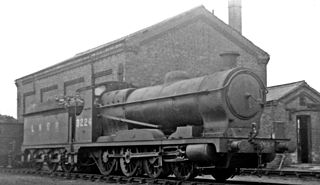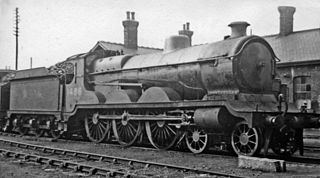
The Great Central Railway (GCR) Class 9F was a class of 0-6-2T steam locomotive built between 1891 and 1901. From 1923 the locomotives were redesignated Class N5.

Stephen Dewar Holden was a British engineer, the son of the engineer James Holden and succeeded his father as locomotive superintendent of the Great Eastern Railway in 1908, a post he held until his retirement in 1912.
Alexander Henderson, 1st Baron Faringdon, known as Sir Alexander Henderson, 1st Baronet, from 1902 to 1916, was a British financier and Liberal Unionist Member of Parliament.
Thomas Wheatley (1821–1883) was an English mechanical engineer who worked for several British railway companies and rose to become a Locomotive Superintendent at the London and North Western Railway (LNWR) and the North British Railway (NBR).

The NER Class X was a class of 4-8-0T tank locomotive designed by Wilson Worsdell for the North Eastern Railway. They were intended for use as powerful shunting engines to arrange and move coal wagons for loading into ships. In total 15 were built, 10 by the NER between 1909 and 1910, and a further five in 1925 by the London and North Eastern Railway (LNER). They had three cylinders with divided drive: the inside cylinder driving the leading axle, the outside cylinders driving the centre.

The Great Central Railway Class 8, known as the London and North Eastern Railway Class B5 following the 1923 Grouping, was a class of fourteen 4-6-0 steam locomotives designed to haul fast goods trains, in particular fish trains.

The Great Central Railway (GCR) Class 8A was a class of 0-8-0 steam locomotive built between 1902 and 1911 for handling heavy coal trains over the Pennines. They all passed to the LNER in 1923, who redesignated them Class Q4. They were withdrawn from service between 1934 and 1951.

The GCR Class 1B was a class of 2-6-4T (tank) locomotives on the Great Central Railway. They were notable as the first locomotives of the 2-6-4T wheel arrangement to be used by a British standard-gauge railway; there had been two narrow-gauge examples on the Leek & Manifold Valley Light Railway since 1904.
The NER 38 Class was a class of 4-4-0 steam locomotives designed by Alexander McDonnell for the North Eastern Railway. Twenty-eight were built in 1884–5, and remained in service until 1915–23.
GCR Classes 8D and 8E were two pairs of three-cylinder compound steam locomotives of the 4-4-2 wheel arrangement built in 1905 and 1906 for the Great Central Railway.

The GCR Class 11E was a type of 4-4-0 steam locomotive used by the Great Central Railway for express passenger services. Ten were built in the railway's own workshops at Gorton, Manchester during 1913; they remained in service until the mid-1950s.

The GCR Class 9Q, classified B7 by the LNER, was a class of 4-6-0 mixed traffic locomotives designed by John G. Robinson for fast goods, relief passenger and excursion services on the Great Central Railway. They were a smaller wheeled version of Robinson's earlier Class 9P "Lord Faringdon" express passenger class.

The GCR Class 5A was a class of seven 0-6-0T steams designed by John G. Robinson for work in docks operated by the Great Central Railway. They passed to the London and North Eastern Railway at the grouping in 1923 and received the LNER classification J63.
Ken Hoole (1916–1988) was an English historian known for his works on the railways of the north east of England.
The Great Eastern Railway was formed on 1 August 1862, when the Eastern Counties Railway changed its name. The ECR had originally been built to 5 ft gauge, was converted to 4 ft 8+1⁄2 instandard gauge in September and October 1844.

The Great Central Railway Class 1A, classified B8 by the LNER, was a class of 4-6-0 mixed-traffic locomotives designed by John G. Robinson for fast goods, relief passenger and excursion services. They were known as the ‘Glenalmond Class’ and were a smaller wheeled version of Robinson's earlier Sir Sam Fay express passenger class, which they closely resembled.

The Great Central Railway (GCR) Class 9A was a class of 0-6-2T steam locomotive built between 1889 and 1892. From 1923 the locomotives were redesignated Class N4.
The North Eastern Railway was formed by merger in 1854 and merged into the London and North Eastern Railway at the grouping in 1923. Between those dates five men held the post of Locomotive Superintendent.

The GCR Class 8F was a class of ten 4-6-0 locomotives built for the Great Central Railway in 1906 by Beyer, Peacock and Company to the design of John G. Robinson for working fast goods and fish trains. They passed to the London and North Eastern Railway at the 1923 grouping and received the classification 'B4'.
The Great Central Railway Class 8N - London North Eastern Railway Class B6 - was a class of three 4-6-0 steam locomotives, designed by John G. Robinson in 1918. They were a mixed traffic class. All three examples were withdrawn in November and December 1947.













